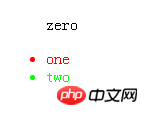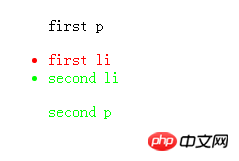Home >Web Front-end >CSS Tutorial >Analyze the difference between nth-child and nth-of-type in CSS3
Analyze the difference between nth-child and nth-of-type in CSS3
- 巴扎黑Original
- 2017-03-14 10:28:541339browse
The difference between nth-child and nth-of-type in CSS3 is actually very simple: Why is :nth-of-type called :nth-of-type? Because it is distinguished by "type". That is to say: ele:nth-of-type(n) refers to the nth ele element under the parent element, and ele:nth-child(n) refers to the nth element under the parent element and this element is ele. If If not, the selection fails.
The text may sound rather obscure, but it is easier to understand. Here is a small example:
<!DOCTYPE html>
<html lang="en">
<head>
<meta charset="UTF-8">
<title>demo</title>
</head>
<style>
.demo li:nth-child(2){
color: #ff0000;
}
.demo li:nth-of-type(2){
color: #00ff00;
}
</style>
<body>
<p>
<ul class="demo">
<p>zero</p>
<li>one</li>
<li>two</li>
</ul>
</p>
</body>
</html>The results are as follows: 
In the above example, .demo li:nth-child(2) selects the 25edfb22a4f469ecb59f1190150159c6onebed06894275b65c1ab86501b08a632eb node, while .demo li:nth-of-type(2) selects 25edfb22a4f469ecb59f1190150159c6 twobed06894275b65c1ab86501b08a632ebnodes.
But what if no tags are specified before nth-child and nth-of-type?
.demo :nth-child(2){
color: #ff0000;
}
.demo :nth-of-type(2){
color: #00ff00;
}What will be the result of this? Look at the html structure:
<ul class="demo"> <p>first p</p> <li>first li</li> <li>second li</li> <p>second p</p> </ul>
Result: 
As can be seen above, before them Without specifying the tag type, :nth-child(2) still selects the second element, no matter what tag it is. And :nth-type-of(2) selects two elements, which are the second p tag and the second li tag in the parent.demo. It can be seen that when the tag type is not specified, :nth-type -of(2) will select the second of all type tags.
We have already understood the basic usage and differences of nth-child and nth-of-type, then go further in nth-of-type(n) and nth-child(n) What is n?
nth-of-type(n) and nth-child(n) n can be a number, keyword or formula. Numbers: This is the use of the above examples, so I won’t go into details. Keywords: Odd, even
Odd and even are keywords that can be used to match sub-elements with odd or even subscripts
Note: The subscript of the first sub-element is 1
Here, we specify two different background colors for odd and even p elements:
p:nth-of-type(odd)
{
background:#ff0000;
}
p:nth-of-type(even)
{
background:#0000ff;
}Formula: or arithmetic Expression
Use the formula ( an + b). Description: Indicates the length of the period, n is the counter (starting from 0), and b is the offset value.
Here, we specify the background color of all p elements whose subscript is a multiple of 3:
p:nth-of-type(3n+0)
{
background:#ff0000;
}If it is: nth-of-type(4n+2), the selected subscript is Multiples of 4 plus all elements of 2
Summary
The above is all about the difference between nth-child and nth-of-type in css3. I hope the content of this article will be useful for everyone to learn or Using CSS3 can be of some help. If you have any questions, you can leave a message to communicate.
The above is the detailed content of Analyze the difference between nth-child and nth-of-type in CSS3. For more information, please follow other related articles on the PHP Chinese website!

